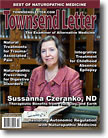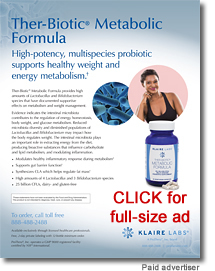|
![]()
From the Townsend Letter |
||||
A Case of Autonomic Dysregulation Syndrome by Richard Kitaeff, MA, NMD, DipAc, LAc |
||||
Page 1, 2 The Case On my initial examination, his pulse rate and temperature were normal, blood pressure was 130/90, chest sounds unremarkable, and salivary pH was 7.0. His tongue was red and slightly dry, and superficial second pulse positions on both wrists (representing stomach and gall bladder organ systems in the traditional Chinese medical system of diagnosis) were excessive. On recent blood chemistry testing, BUN/Creatinine was slightly high, total cholesterol 286, LDL 174, and triglycerides 364. (A previous test for triglycerides showed a level of 712.) Recent findings for Vitamin D 25(OH) were 14.8 and 30.1. HgbA1C was 5.5. Free testosterone at 6.4 and sex hormone binding globulin at 11.7 were both low. On ASI testing, DHEA was borderline low. Hair Mineral Testing showed moderately toxic levels of mercury, aluminum, and titanium; and there were notable deficiencies of magnesium, potassium, copper, sodium, manganese, chromium, boron, lithium, and molybdenum. IgG/IgE Food Allergy testing showed reactions to whey, egg white and yolk, shellfish, banana, pineapple, green bean, kidney bean, brewer's yeast, and mushroom. On the same test, the candida antibody was elevated, agreeing with a high score on the Candida Questionnaire. While initiating a program of treatment, I referred Eric to another cardiologist for a repeat EKG and Holter monitor testing. The cardiologist confirmed the previous diagnosis of PVC's and tried to reassure him that they were benign to allay his anxiety. He considered Eric a candidate for beta blockers but respected his preference for a natural therapy approach.
Eric's symptoms incorporate cardiac, digestive, endocrine, and emotional aspects of autonomic control. Shen and Zipes in Circulation Research write that "the autonomic nervous system plays an important role in the modulation of cardiac electrophysiology and arrhythmogenesis." Furthermore, "the identification of specific autonomic triggers in different arrhythmias has brought the idea of modulating autonomic activities for both preventing and treating these arrhythmias."2 Eric's digestive symptoms may be associated with gastroesophageal reflux disease (GERD), candidiasis, or atrophic gastritis, which is caused by H. pylori bacterium and is characterized by abdominal pain, nausea, and vomiting. His digestive symptoms are reduced by taking hydrochloric acid, and achlorhydria is often consistent with conditions such as gastroesophageal reflux, abdominal bloating, and discomfort. Some medical opinion notes the connection between atrial fibrillation and gastroesophageal reflux disease or "the cardiogastric interaction," due to the close anatomic proximity of the esophagus and the left atrium. Potential atrial arrhythmogenic mechanisms in patients with GERD could be gastric and could involve subsequent systemic inflammation or impaired autonomic stimulation. Treatment of GERD is therefore suggested as a way of avoiding atrial fibrillation.3 Numerous studies have utilized heart rate variability (HRV) and other measures of cardiac or respiratory function to demonstrate dysregulation of autonomic cardiac control by traumatic stress and anxiety.4 A systematic review and meta-analysis of autonomic nervous system dysfunction in psychiatric disorders concludes that "ANS dysfunction is a putative underlying mechanism for increased cardiovascular disease risk in individuals with psychiatric disorders."5 More generally, alteration of ANS reactivity has been found in depressed or anxious patients, dependent on the type of stressor.6 This patient was overweight with borderline high blood pressure, glucose, and HgBA1C and likely a strong hereditary hyperlipidemia, all suggesting metabolic syndrome. Again, there has been medical opinion that "activation of the sympathetic nervous system has an important role in metabolic syndrome" and "treatment strategies commonly recommended for patients with metabolic syndrome, such as diet and exercise to induce weight loss, are associated with sympathetic inhibition." Pharmacological and other approaches have also targeted the sympathetic nervous system.7 Low adrenal and sex hormone status also involve autonomic control. A study utilizing heart rate variability to measure the response to an infusion of angiotensin in healthy men concluded "an unfavorable shift in the cardiac autonomic tone in men with lower testosterone levels in response to a stressor."8 The thread that unites the various cardiac, digestive, emotional, and endocrine symptoms in this case appears to be the factor of autonomic nervous system control. Since this complex of symptoms is far from rare in most medical practice, one could adopt the Medical Symptoms Questionnaire (MSQ) as an initial screening for autonomic dysregulation syndrome. Its rating of symptoms in each category (including head, eyes, ears, nose, mouth/throat, skin, heart, lungs, digestive tract, joints/muscles, weight, energy/activity, mind, emotions) could arrive at a score (a total of 50 or greater) to make a preliminary assessment. The Treatment Page 1, 2
|
||||
![]()
Consult your doctor before using any of the treatments found within this site.
![]()
Subscriptions
are available for
Townsend Letter, the Examiner of Alternative Medicine
magazine, which is
published 10 times each year. Search our pre-2001
archives for further information. Older issues of the printed magazine
are also indexed for your convenience.
1983-2001
indices ; recent indices. Once you find the magazines you'd like to order, please
use our
convenient form, e-mail subscriptions@townsendletter.com,
or call 360.385.6021.
360.385.6021
Fax: 360.385.0699
info@townsendletter.com
Who are
we? | New articles | Featured
topics | e-Edition |
Tables of contents | Subscriptions | Contact
us | Links | Classifieds | Advertise |
Alternative
Medicine Conference Calendar | Search site | Archives |
EDTA Chelation Therapy | Home
© 1983-2017 Townsend Letter
All rights reserved.
Website by Sandy
Hershelman Designs
![]()





